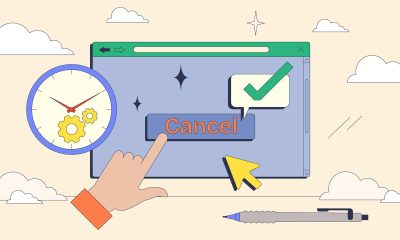Personal Finance
How Much Is Too Much Debt?

Debt is a part of life for many people, but when does it become too much? Debt can be a valuable tool for managing your finances, but too much debt can quickly become overwhelming. Knowing how much is too much debt is critical to managing your finances and avoiding poor credit or financial hardship.
The question remains: How much debt is the right amount for you to take on? You must determine how much debt is too much for your circumstances and how to be proactive in your debt management. These strategies for managing debt are integral for the modern consumer.
With Accredited, you can create a customized plan to be debt free in 24-48 months. See if you qualify.
Join the hundreds of thousands of Americans who have settled credit card debt with Accredited. Click on your state to see if you qualify!
Get Started
Terms & conditions apply.
What is considered too much debt?
Understanding the intricacies of personal debt will give you a clearer picture of how much debt is reasonable for you. It will help you determine if you’ve crossed that line and how to manage your credit health responsibly.
Too much debt can be tricky to define, and the amount is different for everyone. It’s also important to remember that debt isn’t always bad. Taking on debt can be a great way to build credit and make big purchases you couldn’t otherwise afford. The key is to ensure you can handle the payments and that your debt-to-income ratio (DTI) is reasonable.
Calculating your DTI ratio is one of the most helpful steps to get an overall picture of your debt. This ratio compares your monthly debt payments to your monthly pre-tax income, or equity, expressed as a percentage. For example, if your total debt payments are $3,600 and your pre-tax monthly income is $10,000, your DTI ratio would be 36%.
Generally, 36% is considered a good debt-to-income ratio and a manageable level of debt, as no more than 36% of your gross monthly income goes toward debt payments. If your DTI ratio is higher, it may be too much debt to handle.
The average amount of debt among Americans
Though it is a diverse country, Americans have one big thing in common: They carry a staggering amount of debt. The average debt amount isn’t spread evenly across the country, though. It varies based on income level, among other factors. For example, higher-income households tend to carry higher amounts of debt. People in urban areas with typically higher living costs are likely to have more debt than those in rural areas.
So what is the average American debt amount? According to recent figures from consumer credit reporting agency Experian, the average household debt in the third quarter of 2022 was slightly more than $100,000. Most of that debt is tied up in mortgages and auto loans. A significant portion is also in credit cards, student loans, personal loans and medical bills.
9 ways to reduce debt
If you find yourself carrying too much debt, there are a few strategies you can use to help reduce your debt load. Even someone with a lot of debt still has options, so remember: Help is available if you find yourself in over your head.
Determine the root problem
If you have too much debt for your circumstances, it’s essential to identify the root cause of your debt. Why are you taking on too much debt? Are you living beyond your means? Identifying the cause of the problem can help you address the issue. If you haven’t done so lately, check your credit report to get a clear picture of your total debt.
Next, review your spending, especially big purchases, to understand where your money goes. By understanding why you’re in debt, you can develop a plan that addresses the underlying issues. For example, if you have a high interest rate on your debt, you can look into refinancing options or consolidate your debt to lower your interest charges.
Don’t take on new debts
Not taking on new debt may seem like an obvious tip, but that doesn’t make it any less critical. Avoiding new debt lets you focus on paying off existing debt. This helps you avoid accruing more interest, making it easier to pay off what you already owe.
Create a budget
Creating a budget is an excellent way to handle debt because it helps you to understand precisely how much money you have coming in and going out each month. By tracking your income and expenses, you can identify areas where you can cut back and save money. With this information, you can create a plan to pay off your debt and stick to it. Additionally, creating a budget can help you set financial goals to ensure that you stay out of debt in the future.
Cut back on your monthly spending
Cutting back on monthly spending can help you get out of debt by reducing your expenses and leaving more money to put toward your debt. Start by reducing your spending on luxuries — for instance, eating out, shopping and entertainment — and cutting back on non-essential items like brand-name clothing and electronics. Put the money you save toward your existing debt to pay it off faster.
Negotiate better interest rates
Many people don’t realize you can negotiate with debt collectors and creditors for better payment terms. Some people with significant debt hesitate to talk with creditors for fear of repercussions. There’s nothing to worry about — you can’t go to jail for having too much debt (as long as you’re acting in good faith), and it’s in a creditor’s best interest to make it easier for you to pay off your debt.
Negotiating for a better interest rate is worthwhile because it reduces your monthly payments. A lower interest rate will also reduce the amount you pay over the life of the loan, significantly reducing the overall cost.
Before negotiating with creditors:
-
Check your credit score to better understand your bargaining position.
-
Contact your creditors and explain that you would like a lower interest rate.
-
Provide evidence that you’re a reliable customer who has proven they can make payments on time.
You may wish to offer your creditor a lower target interest rate and explain why you think it would benefit both parties. If your creditor disagrees with your proposed rate, offer a compromise. You might suggest a lower rate for a certain period, a payment plan or other advantageous terms.
Realize that contacting a debt or bill collector resets the timer on old debt that may fall off your record. Under the Fair Credit Reporting Act, debts typically only appear on your credit report for seven years. Some people with old debt prefer to let it expire, or fall off their credit report, rather than repaying it. However, paying off old debt is an excellent way to repair your credit. Debt collectors will frequently take a smaller lump sum as payment in full or allow for a low- or no-interest payment plan.
Pay more than the minimum payment
Paying more than the minimum payment on your monthly credit card bill can help you get out of debt more quickly because it will shorten the time it takes to pay off your credit card. Paying more than the minimum due each month can also help you save in the long run, as it will reduce the amount of interest you pay over time.
Focus on paying off high-interest debt first
The debt snowball or debt avalanche methods are two great strategies for paying off debt.
The debt avalanche involves paying off your highest-interest debt first. High-interest debt accrues interest more quickly, meaning your payment ratio is skewed more toward your interest than the principal balance. By focusing on paying off the debt with the highest interest rate first, you can save money and get out of debt faster. The debt avalanche method saves you money in the long run.
The debt snowball method involves making minimum payments on all debt, focusing on paying off the smallest debts before moving on to bigger ones. It can be an excellent way to simplify expenses and allows you to focus on paying off more significant debts after the smaller ones have been handled. Still, be aware that the debt snowball method is a slower way to reduce debt levels, and you’ll be accruing more interest in the process.
Supplement your income
Supplementing your income is another straightforward way to help with debt. A supplementary income could involve:
-
Taking on additional part-time or freelance work
-
Selling items online or through consignment stores
-
Taking on gig economy jobs like ride-sharing or food delivery
Increasing your revenue will generate disposable income, which you can use to pay off your debts faster. This also frees up more of your income for other expenses in the future since your monthly payments will decrease over time as you pay off your debts.
Consider debt relief options
Options for debt relief such as debt consolidation, debt settlement or credit counseling can be excellent ways to manage debt. These tools can reduce the amount of money you owe and give you tools to rebuild your finances.
Debt relief can be a great choice for those wondering how to get out of debt. They can make repayment more accessible by reducing interest rates or setting up a manageable payment plan. They can also help improve your credit score by eliminating late payments and overdue balances. Ultimately, debt relief options provide a way to reduce the debt burden and get back on track financially.
Debt consolidation loans
Debt consolidation loans are a type of loan that lets you combine multiple debts into one loan, usually with a lower interest rate. This can help you save money on interest and make it easier to manage your debt payments. Even with large debt consolidation loans, you can make a single, more affordable monthly payment and pay off your debt faster.
Credit counseling
Credit counseling is a type of financial counseling through which you can receive assistance in dealing with your debt. A credit counseling agency will help you develop a budget and provide education about money and debt management that you can use to regain control of your finances.
Credit counseling may also include debt negotiation with creditors and credit repair efforts to reduce your interest rate or monthly payment amount and erase delinquent debt from your credit report.
Bankruptcy
Bankruptcy is a legal process that allows debtors to eliminate or reorganize otherwise crippling debt. It can provide relief from creditors, stop collection activities and even discharge some types of debt entirely. Bankruptcy can help if you have too much debt to pay, but it should be a last resort as it can severely impact your credit score.
Bankruptcy can be a powerful tool to help those in financial distress get a fresh start and take control of their finances. However, it’s important to remember that bankruptcy has long-term implications and should only be used if you have no better options.
Good vs. bad debt
Understanding the difference between good and bad debt can help you make better purchases and develop sound financial strategies.
Good debt is used to purchase an asset that will appreciate in value over time, such as a home or valuable property. Bad debt is incurred through purchasing an item that will lose value over time, such as a car or consumer goods. Good debt can be beneficial as it can help you build your credit score, but bad debt will almost always detract from it.
There are ways to overcome a high debt load
If you have too much debt, it’s in your best interests to decrease your debt burden and regain financial control. Start by creating a budget that allows you to track your expenses and income while helping you identify areas where you can cut back.
It’s a good idea to prioritize paying off high-interest debt first to reduce the amount of interest you’re paying. This can significantly decrease the financial burden of credit card debt. If you’re still feeling overwhelmed by debt, look into debt relief options such as debt consolidation loans and credit counseling, which can assist with getting your finances back on track.
With a clear plan, sensible budgeting and the proper help, you can tackle your debt and reclaim your financial freedom.
© Copyright 2023 Money Group, LLC. All Rights Reserved.
This article originally appeared on Money.com and may contain affiliate links for which Money receives compensation. Opinions expressed in this article are the author’s alone, not those of a third-party entity, and have not been reviewed, approved, or otherwise endorsed. Offers may be subject to change without notice. For more information, read Money’s full disclaimer.
Read the full article here

-

 Investing7 days ago
Investing7 days agoMoldova breakaway region to face new power cuts on Saturday, officials say By Reuters
-

 Investing7 days ago
Investing7 days agoReebok Co-Founder Backs Syntilay’s New AI, 3D-Printed Shoe
-

 Side Hustles7 days ago
Side Hustles7 days agoHow to Survive High-Demand Seasons Without Losing Customers
-

 Side Hustles5 days ago
Side Hustles5 days ago5 Things That Could Significantly Impact Your Company in 2025
-

 Investing5 days ago
Investing5 days agoNFI Group surge after board reshaped with new appointments, chairperson By Investing.com
-

 Side Hustles7 days ago
Side Hustles7 days agoShake It Up — Dunkin’ Debuts Star-Backed Winter Menu
-

 Side Hustles6 days ago
Side Hustles6 days agoHow Failing 22 Times Paved the Way to My Success
-

 Make Money7 days ago
Make Money7 days ago9 Easy Steps to Begin Your Gold Investment Journey


















